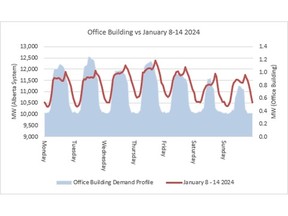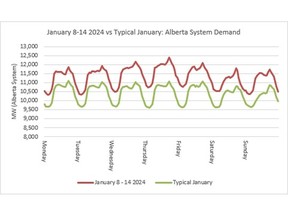
In the minutes after Albertans received an emergency alert on Saturday asking them to power down, many looked to Calgary’s skyline and saw a mosaic of office buildings lighting up the downtown.
As temperatures fell to -35 C and colder, bringing Alberta’s grid under increased strain, criticism of office buildings’ consumption grew hotter.
On Monday, as yet another grid alert was issued, Mayor Jyoti Gondek wrote in a post to X that she was in contact with the association representing downtown building owners to assess their power usage — a clear nod to the question of how Calgary’s large electricity users did their part during the emergency.
But the event also raised questions about whether lower demand among Calgary’s office buildings would have steered Alberta away from the edge of rolling blackouts.
Because the Alberta Electric System Operator (AESO) isn’t involved in local distribution and private utility providers don’t provide detailed information on consumption specific to users, details on office buildings electricity use is largely left to guesswork.
Mostafa Farrokhabadi, an assistant professor at the University of Calgary’s Schulich School of Engineering, said Alberta was in an approximately 300-megawatt deficit before importing power from B.C. and Saskatchewan, and the province was using backup power to meet demand. “We were beyond the edge,” Farrokhabadi said.
Enmax said in a statement to Postmedia that Calgary reduced its load by 60 megawatts on Saturday after the emergency alert was issued. (The utility also said it set a new winter peak last Thursday, with demand at 1,656 megawatts.)
With a 300-plus megawatt deficit, Farrokhabadi said, the most significant cumulative users — particularly in the evening on a weekend — come from thermal appliances such as dryers and washing machines. The total reduction needed during that peak, he said, would amount to one-fifth of the city’s entire energy use at that point in time.
“From the visual perspective, you might think, ‘Oh, all of these lights are on’ . . . but from a numerical perspective, I don’t think those lights alone would have saved the province,” he said.
Thomas Glenwright, an electricity procurement consultant for several downtown Calgary office buildings, said energy demand in office buildings typically drops before the average peak arrives in the evening.
In a chart showing Alberta’s electricity demand compared to one of his clients’ energy consumption, office buildings’ demand dipped before Saturday’s peak and had started falling before the emergency alert went out.

There are few financial incentives available for office buildings to reduce their load, Glenwright added. Alberta companies that can quickly reduce their load by 300 or more kilowatt-hours (0.3 megawatt-hours), as requested by AESO, can opt into a program called Voluntary Load Curtailment that rewards them for shedding demand — a program Glenwright said office buildings aren’t suitable for.
“There’s no financial incentive to dramatically reduce load,” Glenwright said.
He added his clients are locked into fixed-rate contracts that limits their exposure to wildly fluctuating commodity prices, which hit the maximum $999 per kilowatt-hour for several hours on Saturday night.
These factors provide few incentives for office buildings to have demand-reduction plans in these “very, very rare circumstances,” he said.

In a statement to Postmedia, the Building Office Managers Association of Calgary (BOMA) said several downtown towers participate in provincial programs for shedding load and responded to requests over the weekend.
Lloyd Suchet, executive director of BOMA, said office building lights don’t draw significant resources from the grid because they’re largely LED lights. He added lights are often triggered by motion sensors and security often shuts off lights during after-hours sweeps of a building.
He added office buildings on weekends use about 40 per cent of their weekday load.
-
 Perfect storm led to last weekend’s threat of Alberta electricity blackout
Perfect storm led to last weekend’s threat of Alberta electricity blackout -
 Varcoe: After being within a half-hour of rotating outages, AESO head says Alberta is ‘through the worst of it’
Varcoe: After being within a half-hour of rotating outages, AESO head says Alberta is ‘through the worst of it’
“The more impactful measures that were taken are lowering the various fans, motors and pumps for heating and water systems that cannot be seen from the street in a way that lighting can,” he said in an email.
Suchet said Saturday’s events are an opportunity for BOMA to refine its processes in addressing lighting automation going forward.
Gondek’s office said in a Wednesday statement to Postmedia that BOMA has been responsive and collaborative with the city during the cold snap, and said they can build on last week’s experience “to discuss a more integrated and consistent approach that could be deployed if a similar situation arises in the future.”
Despite the argument that office buildings alone likely wouldn’t have prevented an emergency alert, Farrokhabadi said switching off every light helps the grid.
“We have to be careful how we are making the message come across . . . smaller loads accumulate and make a difference at the end of the day.”
X: @mattscace67
You can read more of the news on source


